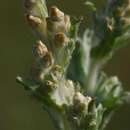Description
provided by eFloras
Erect to decumbent annual herbs, 15-30 cm tall, branched from the base, usually coverd with white woolly tomentum. Leaves linear-obovate to oblanceolate-spathulate, obtuse to apiculate, sessile or base attenuating into a petiole, (0.5-) 0.75-3 (-3.5) x0.3-0.75 (-1) cm, white woolly on the lower surface, glabrescent on the upper surface. Capitula 2.5-3 mm across, campanulate in terminal or axillary dense leafy spikes; phyllaries 2-3-seriate, scarious, pale brownish, outer most woolly, 1-2 x c. 1 mm, ovate-lanceolate with scarious margins and green midrib; inner longer 2-2.5 x c. 0.5 mm, oblong. Outer marginal florets many, filiform, with c. 1 mm long corolla, disc florets 4-6, corolla ± tubular, 5-lobed. Cypselas c. 0.5 mm long, papillose, pappus c. 2 mm long, white, setae free, deciduous separately.
- license
- cc-by-nc-sa-3.0
- copyright
- Missouri Botanical Garden, 4344 Shaw Boulevard, St. Louis, MO, 63110 USA
Distribution
provided by eFloras
Distribution: A widespread weed in tropical and subtropical Africa, Asia, Australia and tropical America.
- license
- cc-by-nc-sa-3.0
- copyright
- Missouri Botanical Garden, 4344 Shaw Boulevard, St. Louis, MO, 63110 USA
Habitat
provided by eFloras
Fl.Per.: Almost throughout the year.
- license
- cc-by-nc-sa-3.0
- copyright
- Missouri Botanical Garden, 4344 Shaw Boulevard, St. Louis, MO, 63110 USA
Derivation of specific name
provided by Flora of Zimbabwe
polycaulon: with many stems
- license
- cc-by-nc
- copyright
- Mark Hyde, Bart Wursten and Petra Ballings
- bibliographic citation
- Hyde, M.A., Wursten, B.T. and Ballings, P. (2002-2014). Gnaphalium polycaulon Pers. Flora of Zimbabwe website. Accessed 28 August 2014 at http://www.zimbabweflora.co.zw/speciesdata/species.php?species_id=159380
- author
- Mark Hyde
- author
- Bart Wursten
- author
- Petra Ballings
Description
provided by Flora of Zimbabwe
Annual herb, branching from the base, up to 25 cm tall but often flowering when only a few cm tall. All parts more or less densely covered in white cobweb-like wool. Leaves sessile or shortly petiolate, spathulate, 1-7 cm long, mucronate at the apex; margin entire. Inflorescence in a terminal spike with leaf-like bracts. Involucral bracts c. 3-seriate, oblong, c. 2 mm long, pale buff or purple-tinged. Florets small, numerous, whitish.
- license
- cc-by-nc
- copyright
- Mark Hyde, Bart Wursten and Petra Ballings
- bibliographic citation
- Hyde, M.A., Wursten, B.T. and Ballings, P. (2002-2014). Gnaphalium polycaulon Pers. Flora of Zimbabwe website. Accessed 28 August 2014 at http://www.zimbabweflora.co.zw/speciesdata/species.php?species_id=159380
- author
- Mark Hyde
- author
- Bart Wursten
- author
- Petra Ballings
Worldwide distribution
provided by Flora of Zimbabwe
Widespread in Asia, Australia, West Indies, Brazil, Egypt, Tropical and South Africa
- license
- cc-by-nc
- copyright
- Mark Hyde, Bart Wursten and Petra Ballings
- bibliographic citation
- Hyde, M.A., Wursten, B.T. and Ballings, P. (2002-2014). Gnaphalium polycaulon Pers. Flora of Zimbabwe website. Accessed 28 August 2014 at http://www.zimbabweflora.co.zw/speciesdata/species.php?species_id=159380
- author
- Mark Hyde
- author
- Bart Wursten
- author
- Petra Ballings
Gnaphalium polycaulon: Brief Summary
provided by wikipedia EN
Gnaphalium polycaulon, the many stem cudweed, is a plant species in the family Asteraceae. It is widespread across much of Mesoamerica, South America, and the West Indies, and naturalized in parts of Asia and Africa.
Gnaphalium polycaulon is a small annual herb up to 25 cm (9.8 in) tall, with several erect to ascending branches. Stems, leaves and phyllaries are covered with a dense coat of woolly hairs, giving the plant a whitish appearance. Leaves are narrowly linear, up to 4.5 cm (1.8 in) long. Flower heads are born in tight, elongated array. Each head contains numerous florets, mostly yellowish but sometimes with purple tips
- license
- cc-by-sa-3.0
- copyright
- Wikipedia authors and editors

